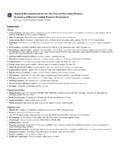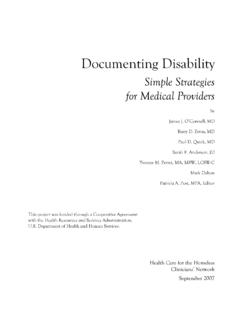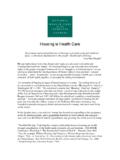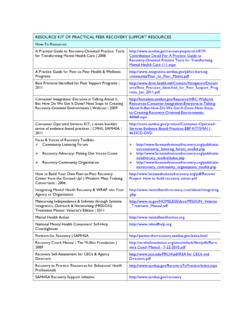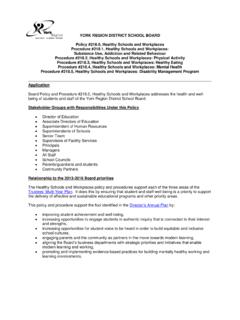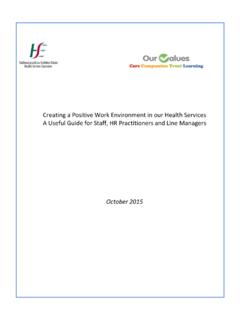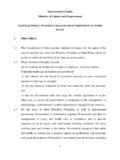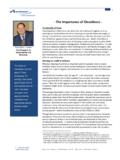Transcription of Creating and Maintaining A Healthy Work Environment
1 Creating and Maintaining A Healthy work Environment A Resource Guide for Staff Retreats Ken Kraybill, MSW National Health Care for the Homeless Council Health Care for the Homeless Clinicians Network This project was supported through a grant from the Health Resources and Services Administration, Department of Health and Human Services May 2003 .. the elements that define a Healthy work Environment [include] collegiality and sharing; recognizing employees contributions; having policies that are based on trust; doing what we say we will do, both individually and as an organization; [and] encouraging employees to have a balanced life. Report on key findings from the Association of Professional Executives of the Public Service of Canada (APEX) colloquium entitled Beyond the Talk: Achieving a Healthy and productive work Environment , 1999 Think of communication as the organizational cardiovascular system.
2 The lifeblood of an entity is nothing without the heart, lungs, arteries and veins to transport it to its destination. Departure from regular and effective communication can eventually atrophy the creative engine of [an organization]. Wanda Shumaker, WJS Consulting Group .. surveys suggest that the main source of stress in the workplace, at every level of the organization, is interpersonal relationships .. studies further indicate that the two most important factors that make staff feel positive about their work Environment are the respect they are given and the recognition of their contribution in the workplace. Ron Sparrow, Vice President, Source Line Corporate Wellness Services Inc. Table of Contents Acknowledgments Introduction Why hold retreats? Purpose and use of the guide Retreat Planning & Evaluation Convening a retreat planning committee Determining retreat goals Choosing a facilitator Selecting a retreat location Promoting the retreat Arranging the retreat space Preparing food Spicing up the retreat Documenting the main points Evaluating the retreat Retreat Content Key Questions & Activities What is the essence of this organization?
3 What are the key characteristics of a Healthy work Environment ? What difference does a Healthy work Environment make? Whose responsibility is it to create a Healthy workplace? How Healthy is this organization? What difference do structural issues make? How important is communication? What does self-care have to do with organizational wellness? What steps can organizations take to create a more vital workplace? Appendices Appendix A Tips for Retreat Facilitators Appendix B Ice-breakers and Energizers Appendix C Group Discussion Methods Appendix D Sample Quiz Questions Appendix E Healthy Organization Handouts Appendix F Sample Staff Satisfaction Survey Appendix G Communication Handout Appendix H Self-Care Handouts Appendix I Selected Resources Appendix J Sample Outline for Day-long Staff Retreat Appendix K Sample Retreat Evaluation Form Acknowledgments The impetus for this project grew out of Health Care for the Homeless Clinicians Network Steering Committee discussions over the past number of years.
4 Various Network members, National Health Care for the Homeless Council staff, and other individuals have provided creative ideas and valuable assistance in developing this resource guide. In particular, I wish to thank Lisa Cunningham Roberts, Jenny Metzler, Jeff Olivet, Ruth Needham, Rachel Rodriguez-Marzec, Betty Schulz, Janna Wilson, Jeff Singer, Tom Lorello, Jen Holzwarth, Brenda Proffitt, and John Lozier for their contributions. Special thanks to Health Care for the Homeless, Inc. in Baltimore and the Seattle Health Care for the Homeless Network for inviting me to facilitate all-staff retreats for their projects. These experiences permitted me to refine many of the themes and activities found in this guide. A particular resource I have found valuable in developing this guide is Training for Transformation (revised edition 2001), written by Ann Hope and Sally Timmel, illustrated by Chris Hodzi, published by Mambo Press, Gweru, Zimbabwe.
5 It is available in the United States from the Grailville Art & Bookstore, Loveland, OH, 45140; 513-683-0202. I am appreciative of such resources that stretch my thinking and spark creative ideas. Finally, thank you to Jean Hochron and others at the Bureau of Primary Health Care, Health Resources and Services Administration, Department of Health and Human Services, for promoting and providing financial support for the development of this resource guide. Introduction Why hold retreats? It can be difficult for people who are deeply committed to their work , such as those who work in Health Care for the Homeless (HCH) settings, to justify taking time to retreat to step back from one s work , to reflect, and see the world through new eyes. Yet it is precisely because of this level of dedication that retreat time is so valuable.
6 Challenging work requires perspective. Stepping back periodically from one s work is critically important to ensure the ability to function well and continue to do so over time. Just as vehicles need regular tune-ups and safety checks to keep them running well, so do organizations and individuals need to be taken off the road and into the shop occasionally. Action without reflection can be costly. The words of Thomas Merton are applicable and instructive: The rush and pressure of modern life are a form, perhaps the most common form, of its innate violence. To allow oneself to be carried away by a multitude of conflicting concerns, to surrender to too many projects, to want to help everyone in everything is to succumb to violence .. It destroys the fruitfulness of one s work , because it kills the root of inner wisdom, which makes work fruitful.
7 Retreats essentially provide an opportunity to be reminded of the authentic calling of our lives and organizations. Retreats can help to keep us grounded in the values and practices that make this work meaningful. A solid foundation contributes appreciably to sustaining Healthy work habits and a Healthy organization. It is known from the literature and from experience that the nature of the work Environment is a strong determinant in successfully recruiting new staff, enhancing job satisfaction, and retaining quality staff. These are issues of critical importance to HCH projects. High rates of staff turnover can be costly and negatively affect the quality of care delivered. Thus, it is beneficial for organizations to actively pursue Creating a Healthy work Environment . Purpose and use of the guide The intent of this resource guide is to assist HCH projects in conducting staff retreats that increase morale, commitment to mission, mutual understanding, staff cohesion, and staff retention.
8 These aims are brought together under the theme of Creating and Maintaining a Healthy work Environment . The concept of a Healthy work Environment is not easily defined. Individuals and organizations will characterize it differently. For the purposes of this guide, a Healthy work Environment refers to an organization in which people are valued and priority is given to the multiple aspects of the workplace that affect employees ability to function well in order to accomplish the goals of the organization. It is anticipated that this resource will be particularly helpful to administrators, team leaders, and retreat planning groups in developing staff retreats. While Creating a Healthy work Environment is a shared responsibility of everyone in the organization, it is the particular domain of the leadership to attend to this Environment , set a proper tone, and initiate practices that promote organizational wellness, such as retreats.
9 While this guide is intended for HCH projects, the ideas and activities contained here have broad applicability to other settings and organizations as well. These materials can be adapted as needed. This guide is written primarily with a day-long staff retreat in mind. It is common for organizations to hold such an event on an annual basis. It is important to remember, however, that the nature of this work requires more frequent practices of retreat and renewal. It would be erroneous to think that staff simply need one day of respite annually in order to get back in the saddle again for another year. Retreats come in various shapes, sizes and forms. They can be scheduled for a day to several days. Mini-retreats, taken in the course of the workday, can be even shorter. Retreats can serve a variety of purposes.
10 Some might focus on renewal, others on surveying the external Environment , identifying problems, planning programs, developing new models, and so forth. Retreats can also be held for diverse groups of people. They might include the entire staff of an organization, representatives from various program areas, specific programs, or teams. No one retreat will be like another. This resource guide offers a menu of themes and activities relevant to Creating a Healthy work Environment . Because retreats need to be planned with an organization s specific context and needs in mind, this resource is not written as a recipe to be followed precisely. Instead, it offers ideas and themes to stimulate thinking so that the retreat might best serve the needs of the organization. The guide is organized in three main sections followed by appendices.

